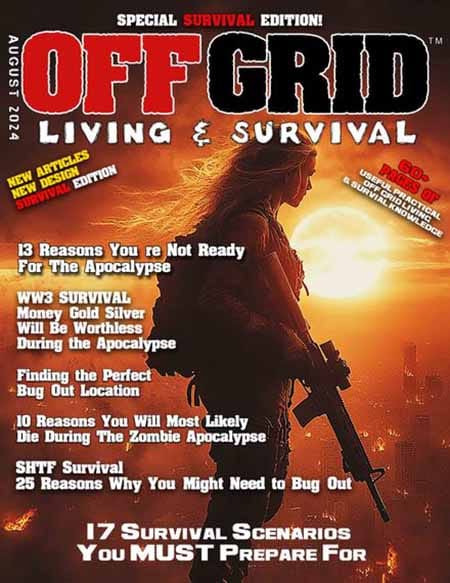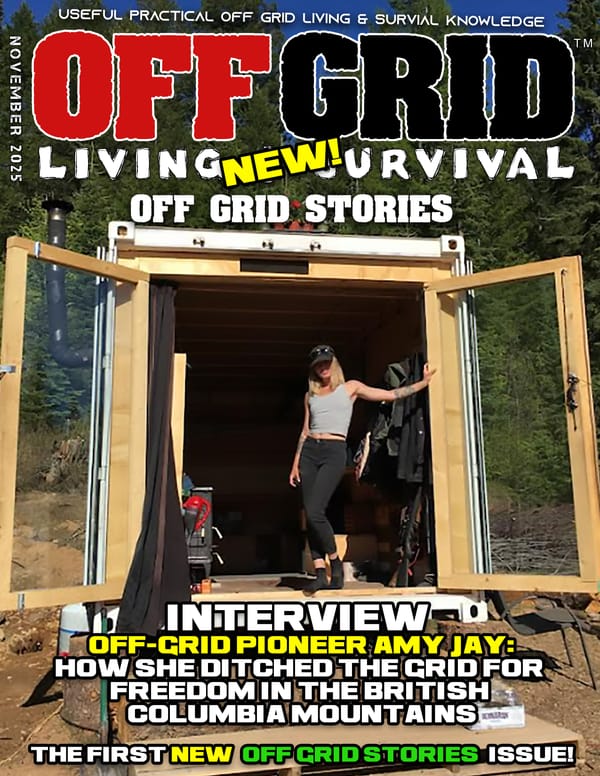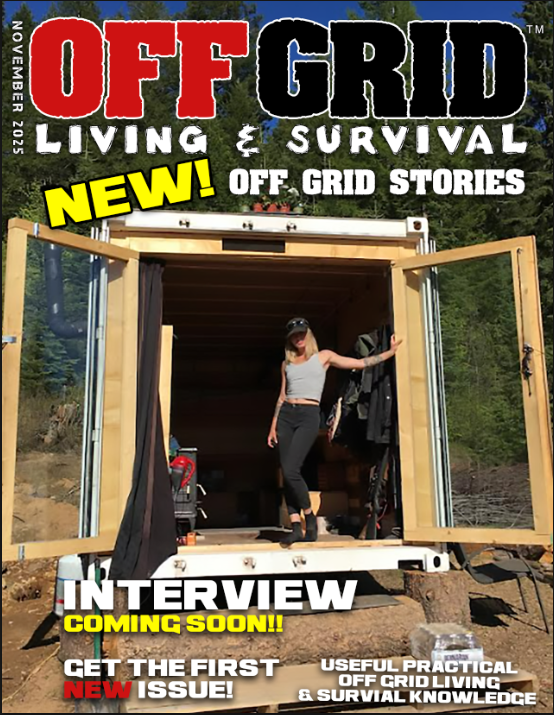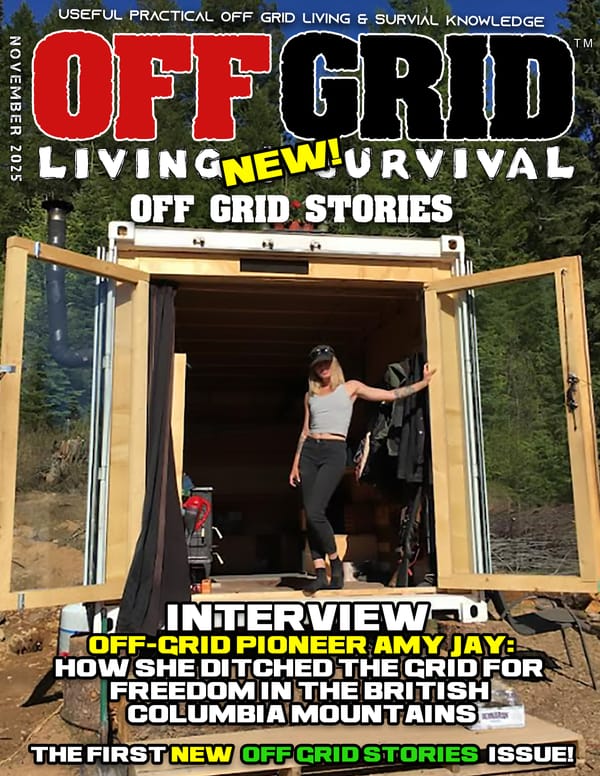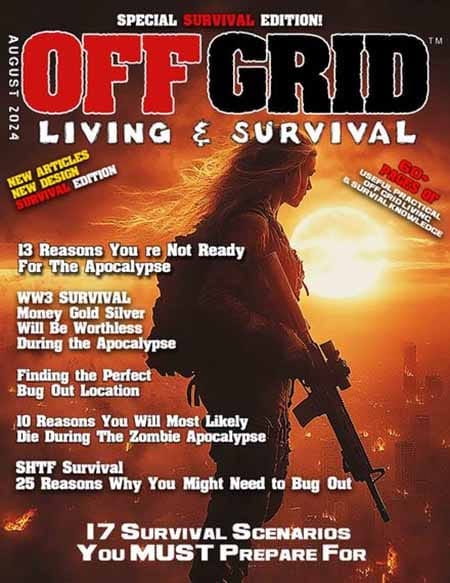NEW MAGAZINE ISSUE! What Economic Collapse Looks Like—And the Way Out
Look around you. It could get a lot worse. But, there's a way out of this mess.
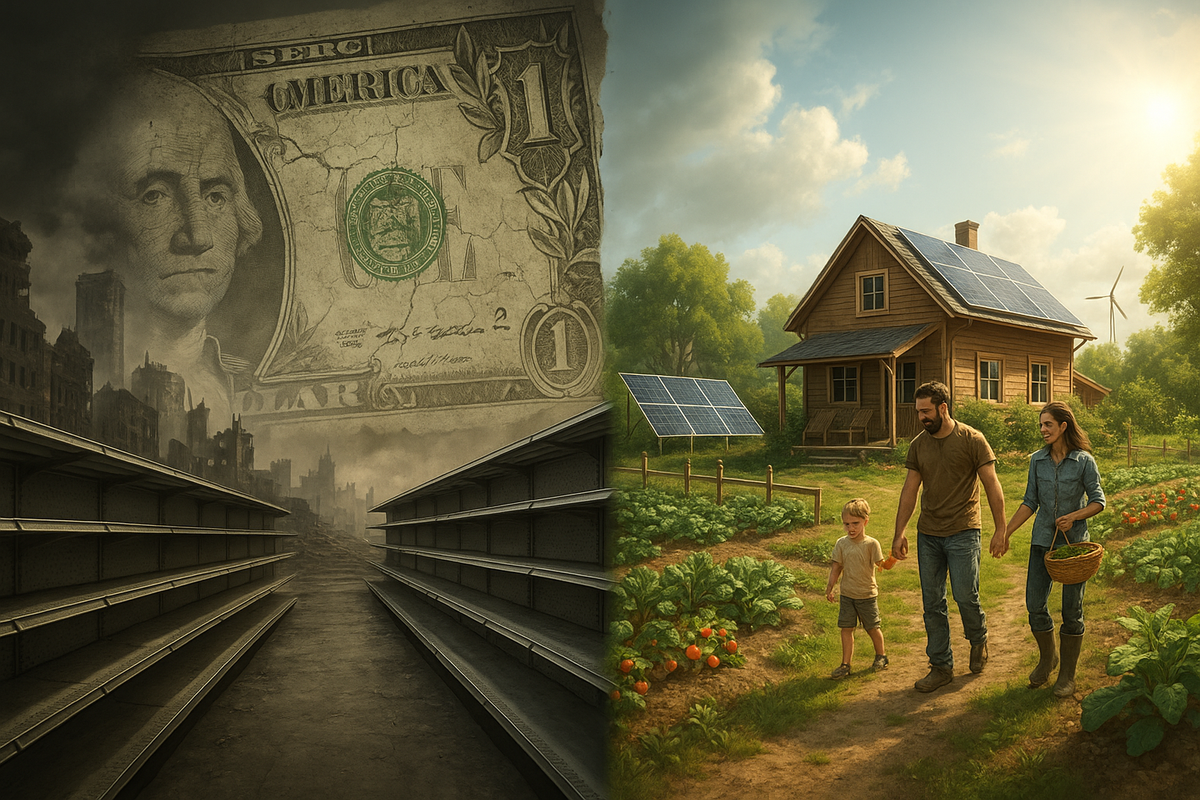
We are close to a global economic collapse. Whether people agree or not doesn’t matter, the reality is unfolding regardless of opinions. This is not fearmongering; it’s fact. The U.S. debt is unsustainable, the dollar is weakening, inflation is unstable, interest rates are crushing growth, and tariffs are hurting Americans while straining international relationships. Meanwhile, the wealthy consolidate more power and resources as everyone else struggles.
This issue of the magazine is for subscribers only. Click HERE to Subscribe Now and read the full issue:
Cost of living is increasing so fast and so drastically that everyone is struggling just to get by. This is a sign of how bad things are.
Here's some numbers:
- Inflation (U.S.): ~ 2.9 % year-over-year as of August 2025 USAFacts+1
- Federal funds / benchmark interest rate (recent): ~ 4.25 % – 4.50 % YCharts+3Trading Economics+3Fed Prime Rate+3
- U.S. national debt: ~$37 trillion (total federal government debt, 2025) Wikipedia
- U.S. dollar index (broad, trade-weighted): ~ 120.98 (Aug 2025, base Jan 2006 = 100) FRED
- Dollar vs major currencies (DXY): ~ 98.383 in early September 2025; down ~ 3.25 % over the past year Trading Economics+2Trading Economics+2
| Metric | ~5 Years Ago | Most Recent / 2025 | Change / Trend |
|---|---|---|---|
| Inflation (U.S.) | ~1.4-1.7 % in 2020 | ~2.9 % in 2025 (Aug) Trading Economics+2USAFacts+2 | Inflation has been elevated especially since 2021; higher than earlier years |
| Federal funds / benchmark interest rate | Very low (near 0-0.25 %) in 2020 | ~4.09 % (effective federal funds, Sept 2025) Federal Reserve+2Trading Economics+2 | Huge increase in rates over the period |
| U.S. national debt | In 2020, about $26-28 trillion (rough ballpark)¹ | Over $37 trillion by 2025 FiscalData+1 | Steady climb, large added liabilities |
| Dollar / dollar index strength | Harder to pin one number (index shifts), but dollar was stronger relative to many currencies earlier | In 2025, the U.S. dollar is under pressure; some measures (trade-weighted indices) show depreciation | General weakening trend against key baskets over time |
The cost of living continues to rise, and households everywhere are fighting just to keep up. Cash flow drives the system, but the system itself is breaking down. This isn’t only an American problem, it’s global.
The U.S. dollar underpins the world economy. If it loses too much value, what happens to international markets? And what happens here at home when the foundation cracks?
When a system like this finally tips over, it doesn’t collapse in theory, it collapses in real life, in real time, for ordinary people. The numbers on Wall Street screens translate into empty shelves in your local store.
The abstract talk about debt ceilings and interest rates becomes families deciding whether to pay rent or buy groceries.
When inflation eats into wages, and when supply chains fail to deliver, the entire society feels it at the ground level.
The warning signs have been ignored for decades, but when the breaking point comes, the decline will not be gradual for most households. It will be fast.
The average American doesn’t have more than a few days’ worth of food in the pantry. Most can’t cover a sudden expense, let alone survive weeks without income or deliveries.
The system is built on movement, money moving, trucks moving, goods moving, fuel moving.
When that motion stops, everything people take for granted grinds to a halt almost immediately.
We’ve seen this before in other countries: economic crises turn into food shortages, banking restrictions, blackouts, protests, and sometimes civil unrest.
The United States is not immune.
In fact, because the dollar is tied to the global economy, disruption here magnifies disruption everywhere.
What happens abroad rebounds here, and what happens here ripples abroad.
When the trucks stop, when the banks freeze, when the grid strains under pressure, collapse will not be a news headline, it will be the empty stomach of your child, the dark tap that no longer flows, the closed pharmacy window when you need medicine.
This is what it looks like when the system breaks down in real terms
First 24 hours
People head straight to grocery stores, gas stations, and pharmacies. Shelves are stripped of bottled water, canned food, rice, beans, bread, baby formula, and basic medicines. Gas pumps run dry. ATMs run out of cash. Debit and credit systems get unreliable as networks overload. Police and EMS calls increase, but they still respond normally.
Lines form everywhere. Supermarkets are crowded, parking lots jammed, tempers short. Fights break out over basic goods like bottled water and diapers. Pharmacies are overwhelmed with people trying to fill prescriptions all at once. Prices jump in some places as store managers try to ration what little stock is left.
Police and EMS see a surge in calls, traffic accidents from overcrowded roads, thefts, disputes, shoplifting, and medical emergencies from people collapsing in the stress and chaos. They respond as best they can, but the workload spikes. Hospitals and clinics remain open, though staff notice the first shortages of supplies like gloves, masks, and saline bags.
At home, families begin to realize how little they actually have stored. Most discover only a few days’ worth of food in their pantries. Freezers and refrigerators are full, but power reliability is already a concern. Parents reassure their kids, but privately begin worrying about how to stretch what they’ve got. People call relatives in other towns, debating whether to leave immediately or wait to see if the crisis passes.
Social media and local news explode with rumors, some exaggerated, some true. Reports of shortages spread faster than the shortages themselves, fueling more panic buying. In some areas, local officials appear on TV or radio urging calm and promising resupply, but trucks aren’t moving. Trust begins to erode.
By the end of the first day, communities look very different than they did the morning before. Store shelves are bare, fuel is scarce, cash is gone, and everyone feels the first wave of uncertainty settle in. The system still functions, but the cracks are visible.
Day 2–3
No new deliveries arrive. Grocery stores and restaurants run out of stock and shut their doors. Pharmacies have no resupply; common prescriptions like insulin, antibiotics, and inhalers are gone. Bottled water is unavailable anywhere. Tap water still runs, but some areas start issuing boil advisories. Families begin leaving urban centers to stay with relatives in less populated areas. Police and emergency services are present but stretched thin, prioritizing urgent calls.
The supply chain that normally restocks shelves overnight is silent. Grocery stores close their doors, some locking them entirely, others leaving aisles half-empty and chaotic. Restaurants shut down once their perishable food is gone; a few try to serve limited menus but quickly run out. Fast food chains that normally depend on daily shipments are dark by the end of the second day.
Pharmacies can’t refill prescriptions. Medications like insulin, inhalers, blood pressure pills, and antibiotics are gone within hours. Families with chronically ill members begin to panic, some going from pharmacy to pharmacy only to find empty counters. Small fights break out in lines as people beg for whatever is left behind the counter.
Bottled water has completely disappeared. People turn to tap water, but in some towns boil advisories are issued after water treatment plants start running low on chemicals or testing shows contamination. Many ignore the warnings, not realizing the risks of waterborne disease until it’s too late.
Families begin leaving cities. Highways fill with cars as people head toward relatives in rural areas, hoping smaller communities will have supplies. Gas stations that still have fuel see long lines and armed guards in some places; most are already out. Those without vehicles start walking or looking for public transit, but buses and trains are overcrowded or canceled due to lack of fuel and staff.
Police and emergency services remain active but are stretched thin. Officers respond only to the most urgent calls, violent crimes, major accidents, and medical emergencies. Reports of looting rise, though many are just desperate families taking food from closed stores. Fire departments struggle as hydrant systems in some areas show pressure drops due to failing pumps.
Hospitals fill quickly, not only with the normal flow of patients but with those who can’t get medications, those injured in crowds or traffic accidents, and those dehydrated from poor water. Staff shortages begin as some nurses and doctors stay home to care for their own families.
The sense of unease deepens. What started as panic buying on day one now feels like a true breakdown. People begin talking less about “when things get back to normal” and more about “how long they can hold out.” Trust in reassurances from government and media weakens. Communities are on edge, waiting to see if help arrives, or if this is only the beginning.
Day 4–7
Power outages begin to last longer. Some municipal water systems fail because treatment chemicals aren’t being delivered or because pumps lose power. Trash collection halts, garbage piles up, and vermin become more common. Food in refrigerators and freezers spoils. Theft and break-ins rise steadily. Informal trading starts, cigarettes, alcohol, canned goods, and fuel become barter items.
Utility crews work where they can, but without steady fuel, parts, or safe access, many systems remain down. Streetlights go dark at night, leaving whole blocks in shadow. Apartment buildings without backup generators lose elevators, heat, and water pressure.
Municipal water systems begin failing in more areas. Some plants shut down entirely because the chemicals used to treat and disinfect water are no longer delivered. Others simply lose pressure when pumps can’t be powered consistently. Boil advisories expand into “do not drink” notices. People line up at public parks and rivers with buckets, hoping to find water sources they can filter or boil.
Trash collection stops. Bags pile up in alleys and curbside bins overflow. With the growing heat of spoiled food, vermin multiply, rats, insects, and stray animals drawn by the smell. The spread of garbage makes neighborhoods feel and smell like they are breaking down.
Refrigerators and freezers, without steady electricity, become useless. Families throw out spoiled milk, meat, and vegetables. Fresh produce is already long gone, leaving people with only dried, canned, or boxed goods if they planned ahead. Malnutrition begins quietly: meals are cut in half, children go to bed hungry, and the weak and elderly feel it first.
Theft and break-ins rise steadily. Some are opportunistic, others are organized. Houses and apartments with visible supplies, cases of water, bags of rice, working generators, become targets. Police, already stretched thin, cannot respond to every call. Many residents stop reporting crimes altogether, knowing no one will come.
Informal trade starts to take shape. Cigarettes, alcohol, painkillers, canned goods, and fuel become barter items. Neighbors begin trading among themselves: a few gallons of gasoline for a bag of rice, or bottled water for medicine. In some areas, open-air markets pop up in parking lots or community centers, with people laying out whatever they can spare in exchange for something they need.
By the end of the first week, the rhythm of life has completely shifted. The old routines, school, work, commuting, shopping, have been replaced with survival routines: finding water, securing food, staying safe, and keeping watch. The question is no longer “if” things will return to normal, but “how long” people can last like this.
Week 2–3
If the supply system is still down, groups begin forming to secure and distribute resources, sometimes neighborhood-based, sometimes criminal. Violence tends to occur around grocery warehouses, fuel depots, pharmacies, and water sources. Larger numbers of people leave cities in search of food and water. Disease outbreaks start due to contaminated water and lack of sanitation. Hospitals run out of essential supplies and function only on remaining stock and generators.
if supplies have not resumed, daily life in most cities shifts into survival mode. The normal economy is gone. What remains is a patchwork of neighborhood groups, improvised markets, and criminal organizations, all competing to control food, water, fuel, and medicine.
In some communities, residents band together to pool resources and defend their blocks. Churches, schools, and community centers become hubs for shared meals or water distribution, with rules enforced by volunteers or local leaders. In other places, criminal crews or gangs take over abandoned warehouses, fuel depots, or pharmacies, using force to control access and charging whatever they want in barter or cash. Ordinary families are caught in between, either submitting to these groups for protection or trying to stay invisible.
Violence concentrates around resource points. Grocery warehouses are stormed once word spreads that stock remains inside. Fuel stations that still have underground reserves become flashpoints, guarded by armed groups or raided by desperate crowds. Water sources are contested. A public fountain or park spigot can attract hundreds, and fights break out when the supply runs low.
Migration out of cities increases sharply. Highways are clogged with vehicles running on their last gallons of fuel, many abandoned on the roadside when tanks run dry. Families walk with carts and backpacks, trying to reach relatives in rural areas. Smaller towns experience their own shortages as they struggle to absorb the influx. In many places, locals resist outsiders, and conflict grows at the edges where urban refugees meet rural communities.
Disease begins spreading. Without trash removal, pests carry illness. Without clean water, diarrhea, dysentery, and other waterborne diseases appear. Children and the elderly are hit hardest. Clinics are overwhelmed, but without antibiotics, IV fluids, or clean beds, staff can do little. Hospitals run on emergency generators, but diesel supplies are dwindling. Doctors and nurses face impossible choices about who gets the last of their medicine or electricity.
The psychological strain deepens. After two weeks, the idea of “waiting it out” fades. People stop expecting a quick fix and accept that this is the new reality. Some adapt by organizing and cooperating. Others turn inward, guarding what they have with weapons. A few exploit the chaos to expand their control. The dividing line between order and disorder now depends on who lives around you and how your community responds.
By the end of the third week, the collapse no longer feels temporary. It feels permanent. The longer the trucks remain idle and the grid unstable, the harder it becomes to imagine a return to normal life.
Month 1–2
Some areas stabilize if trucks start running again and supplies are rationed. Others remain in severe shortage. Mortality rises mainly from dehydration, waterborne illness, untreated infections, and lack of medical care, not from direct violence. Communities with wells, gardens, livestock, tools, and cooperative organization survive better than isolated households trying to manage alone.
By the first and second month, the picture is uneven. Some regions begin to stabilize if limited trucking and supply convoys resume under military or government control. Distribution centers open in stadiums, schools, or parking lots where food and water are rationed. People stand in long lines for hours, often receiving just enough to last a day or two. Order is fragile but possible where authorities re-establish control.
In other areas, shortages remain severe. Without resupply, whole neighborhoods are abandoned. Apartment buildings stand empty after residents either fled or died. Urban centers without functioning logistics resemble ghost towns at night, with only the sound of generators or gunfire breaking the silence. In the hardest-hit zones, barter and black markets dominate daily life.
Mortality rises steadily. The majority of deaths come not from violence but from breakdowns in basic survival needs. Dehydration from lack of safe water. Diarrheal diseases from contaminated sources. Infections from untreated wounds. Chronic illnesses that go unmanaged when insulin, heart medications, and inhalers run out. Hospitals operate on skeleton crews if at all, often running generators only in critical units. Patients overflow into hallways, many without power or clean supplies.
Communities with independent water sources, wells, springs, rain catchment, fare far better. The same is true for those with small gardens, livestock, or preserved food. Rural families accustomed to self-reliance survive, though many face pressure from desperate outsiders arriving from the cities. In towns where neighbors cooperate, food is pooled, patrols are organized, and waste is managed, survival rates improve dramatically. Where trust breaks down, hunger and violence take over.
Social divisions sharpen. The wealthy and well-prepared insulate themselves behind private security and stockpiles. The poor and vulnerable suffer the most. In some regions, refugees form camps on the edges of towns, living in makeshift shelters and depending on charity or theft to survive. Tensions rise as locals resist taking in more mouths to feed.
By the end of the second month, society is split into pockets of relative stability and pockets of collapse. Some places resemble functioning towns, rationed but organized. Others resemble failed states within a state, ruled by whoever controls resources. The line between them is thin, and movement across that line, whether as a refugee, a raider, or a relief worker, defines the daily struggle for millions.
Breakdown of essentials
Food:
Grocery stores carry about three days of supply at normal demand. Restaurants carry one to three days at most. After that, only private stockpiles, farms, or gardens provide food.
Water:
Bottled water is gone in the first day. Tap water works until power or chemical supplies run out at treatment plants. After that, boiling or filtration is required. Without these, diarrhea and dehydration spread quickly.
Shelter:
There are plenty of physical structures, but access and safety are issues. Housing is not the bottleneck; heating, cooling, and security are.
Power:
Without fuel or maintenance, outages last longer. Refrigeration, medical devices, and communication systems fail. Generators and solar setups become critical for small groups.
Medicine:
Pharmacies and hospitals deplete supplies within days to weeks. Painkillers, antibiotics, insulin, and inhalers become unavailable. Minor injuries become life-threatening without sterile water and antibiotics.
Security:
People defend food and water. Lone households with visible stockpiles become targets. Small groups or neighborhoods coordinating for security are safer. Violence centers around contested resources, not random attacks.
It doesn't have to go there.
We don't have to worry if we simply work together come together and stop the stupid.
A Way Out
It doesn’t have to end in collapse.
Fragility is not the same as failure, and hardship is not the same as ruin. The system we live in is showing cracks, but cracks can be repaired, and broken structures can be rebuilt stronger if we have the will.
The first step is acknowledging reality.
Debt, inflation, interest, tariffs, and wealth inequality are not abstract debates, they are real pressures felt by every household. Ignoring them only ensures a harder landing later. Facing them now means we can prepare, adapt, and reduce the shock.
At the national and global level, that means governments focusing less on endless borrowing and more on sustainable budgets.
It means investing in real production, energy independence, and resilient supply chains instead of relying entirely on “just in time” systems that snap under stress.
It means restraining corporate monopolies and redirecting wealth toward communities that actually keep the economy alive. These changes are political choices, not impossibilities.
But waiting for politicians to save us is not enough. At the household and community level, we need to relearn the skills and systems that kept people alive before the age of instant convenience.
That means building local food security, gardens, small livestock, co-ops.
It means water security, wells, filters, rain catchment.
It means practical backup power, solar, batteries, small generators.
It means neighbors organizing with each other instead of waiting for top-down rescue.
Most of all, it means rebuilding social trust. In any disruption, the people who survive aren’t the lone wolves with stockpiles, it’s the communities that share, coordinate, and protect each other.
If we strengthen those bonds now, before a crisis, we won’t just endure a breakdown, we’ll be positioned to build something better on the other side.
The warning is clear: the system is fragile. But fragility also gives us a choice.
We can keep pretending nothing is wrong until the day trucks stop rolling.
Or we can take steps now, while we still have time, to soften the blow and preserve the knowledge, skills, and solidarity that really sustain us.
The way out is not fear, and it’s not denial. The way out is preparation, resilience, and community.
That’s how we make sure an economic crisis, no matter how deep, is not the end of civilization but the beginning of a new way of living.
A new way of living means stepping off the treadmill of dependence and reclaiming real freedom. Off-grid living is not about isolation, it’s about independence. It’s about producing more than we consume, storing what we need, and being able to weather storms without waiting for the system to catch up. It’s not a fringe idea anymore; it’s the blueprint for resilience. Food, water, shelter, and power created locally give people the security to live without fear and the strength to thrive without debt or dependence.
If enough of us take this seriously, we change the equation. The less dependent we are on fragile supply chains and corrupt politics, the less power elites and corporations have to dictate the terms of our survival. That independence is the seed of freedom, and when shared at scale, it becomes the foundation of a stronger, fairer society.
This is also how we avoid civil war and world war. Societies collapse into conflict when people are hungry, thirsty, powerless, and desperate. But when basic needs are secured—when families have food in storage, when neighborhoods have gardens and wells, when communities cooperate instead of fracture—the spark of violence never finds dry tinder.
We can and must demand more from our representatives. They must be reminded that they serve us, not themselves, not lobbyists, not corporations. That means organized pressure, civic participation, and relentless insistence that the policies they pass build stability, not just profit. They need to hear that real representation looks like supporting food security, infrastructure, sustainable energy, fair wages, and the protection of human rights. If they won’t listen, we replace them with leaders who will.
Moving forward doesn’t have to mean upheaval. It doesn’t have to mean riots in the streets, burning cities, or violent rebellion. It can mean millions of us steadily choosing a different path, proving by example that independence and cooperation work better than dependence and division. It can mean taking back control of our lives not by tearing everything down, but by building parallel systems that lift us all up.
Together, united, we can choose preparation over panic, community over chaos, and peace over war. That is how we avoid collapse, how we prevent violence, and how we create a better world for ourselves and the generations to come.
I don't know about you, but I don't want my child growing up in a warzone or an economic depression. I'm willing to work together to build a better place for us all as long as we're all working together and not against each other.
We have the power to build a better world.
So... let's build it.
Off Grid!
